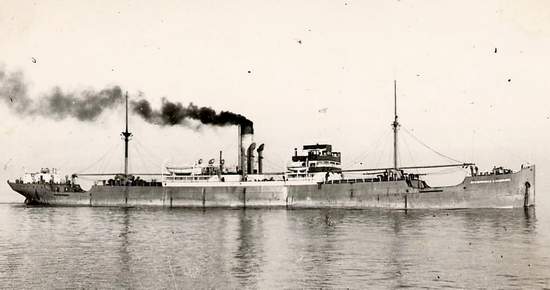Epaminondas C. Embiricos
Greek Steam merchant

Photo Courtesy of Library of Contemporary History, Stuttgart
| Name | Epaminondas C. Embiricos | ||
| Type: | Steam merchant | ||
| Tonnage | 4,385 tons | ||
| Completed | 1927 - William Pickersgill & Sons Ltd, Sunderland | ||
| Owner | Constantine E. Embiricos, Athens | ||
| Homeport | Andros | ||
| Date of attack | 15 Feb 1944 | Nationality: | |
| Fate | Sunk by U-168 (Helmuth Pich) | ||
| Position | 1° 30'N, 73° 00'E - Grid LC 8777 | ||
| Complement | 42 (4 dead and 38 survivors). | ||
| Convoy | |||
| Route | Colombo, Ceylon (13 Feb) - Lourenço Marques, Portuguese East Africa | ||
| Cargo | Ballast | ||
| History | Completed in November 1927 as British Benton for A. Stott & Co, Cardiff. 1931 sold to Greece and renamed Epaminondas C. Embiricos. | ||
| Notes on event | At 18.15 hours on 15 Feb 1944 the unescorted Epaminondas C. Embiricos (Master Constantinos A. Marmaras) was hit on the port side by a dud torpedo from U-168 about 130 miles north of the Addu Atoll, Maldives. The ship was zigzagging at the maximum speed of 10 knots after a first torpedo was seen to pass underneath the ship just ahead of the bridge about 25 minutes earlier. At 18.30 hours, the U-boat was seen to cross the bow from port to starboard while opening fire with its AA guns at the bridge, the boat deck and the after gun platform on the poop. The ship was armed with one 12pdr, two 20mm and four machine guns, manned by four gunners of the Royal Hellenic Navy, but they had no opportunity to return fire as the attack lasted less than four minutes. The master then ordered the crew to abandon ship after the engines were stopped. However, the starboard lifeboat was lowered while the ship was still moving and swamped, so most crew members left in the port boat and waited alongside for the officers who stood on deck, discussing the matter and wondering why no deck gun was used in the attack and no further torpedoes were fired. They could not know that U-168 was not fitted with a deck gun and Pich apparently no longer trusted the four remaining torpedoes and had them checked before carrying out the next attack like a torpedo boat, firing one torpedo from a very close distance at about 21.00 hours. The freighter was struck on the starboard side in the cross bunker and the men still aboard immediately abandoned ship in the port boat, which picked up two or three men that had jumped overboard and then rowed away. The Epaminondas C. Embiricos remained afloat on an even keel after the torpedo hit, but broke in two and sank within a few minutes after being hit by two coups de grâce at 21.20 and 21.25 hours. Four crew members were lost. At about 22.10 hours, the U-boat came alongside the port lifeboat, questioned the occupants and asked for the master and the chief engineer who were taken as prisoner aboard before leaving the area after 20 minutes. As the lifeboat was overcrowded, the survivors searched for the swamped boat and transferred some men after bailing it out with the second officer taking command. The boats were separated the next evening, but were both located by Catalina flying boats on 19 February and the next day all survivors were picked up by HMS Overdale Wyke (FY 338) and HMS Fara (T 162) (T/Lt J.M. Walton, RNVR) and taken to Addu Atoll, where they were landed on the night of 21 February. On 11 March, U-168 met the German tanker Brake and transferred the prisoners to the supply ship during refueling the next day. However, the tanker was located and sunk by Allied warships later that day, but most of her crew, including the prisoners, were rescued by the U-boat and landed at Batavia on 24 March. The men from the Greek ship were handed over to the Japanese and taken to a POW camp. The captivity of the master prevented Allied authorities from taking disciplinary actions as he had ordered the abandonment of an apparently undamaged ship that then remained stopped for two hours against a standing order. | ||
| On board | We have details of 3 people who were on board. | ||
If you can help us with any additional information on this vessel then please contact us.
